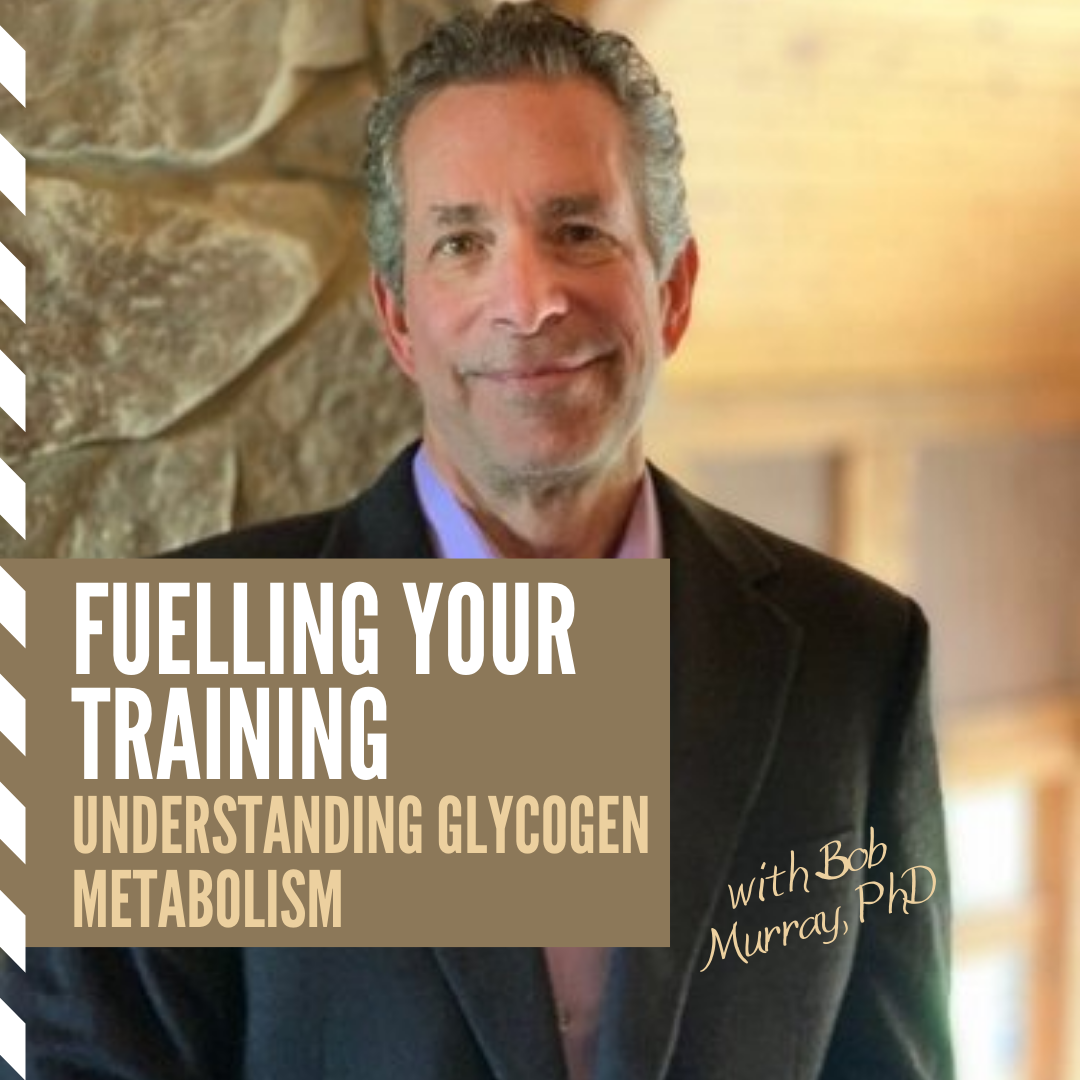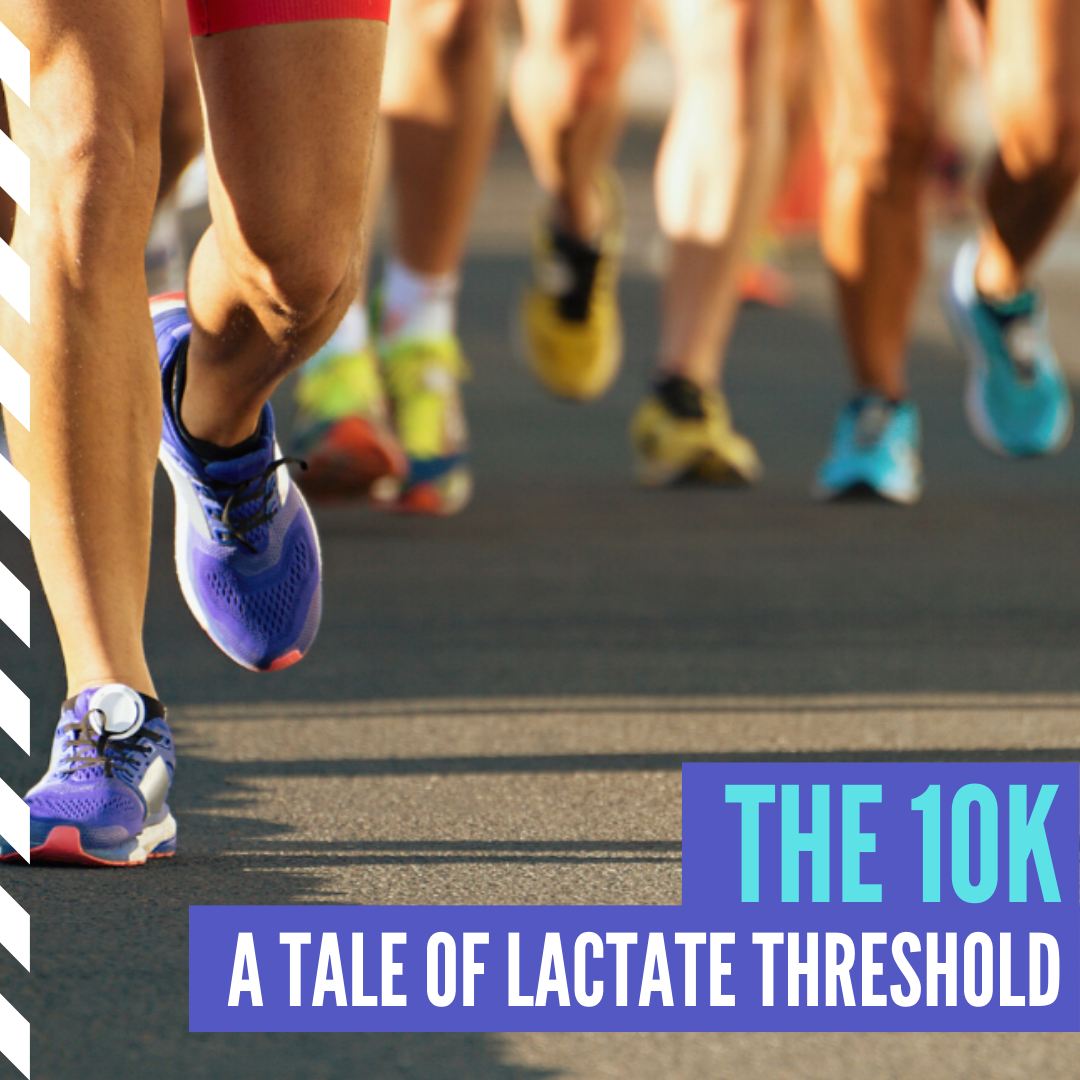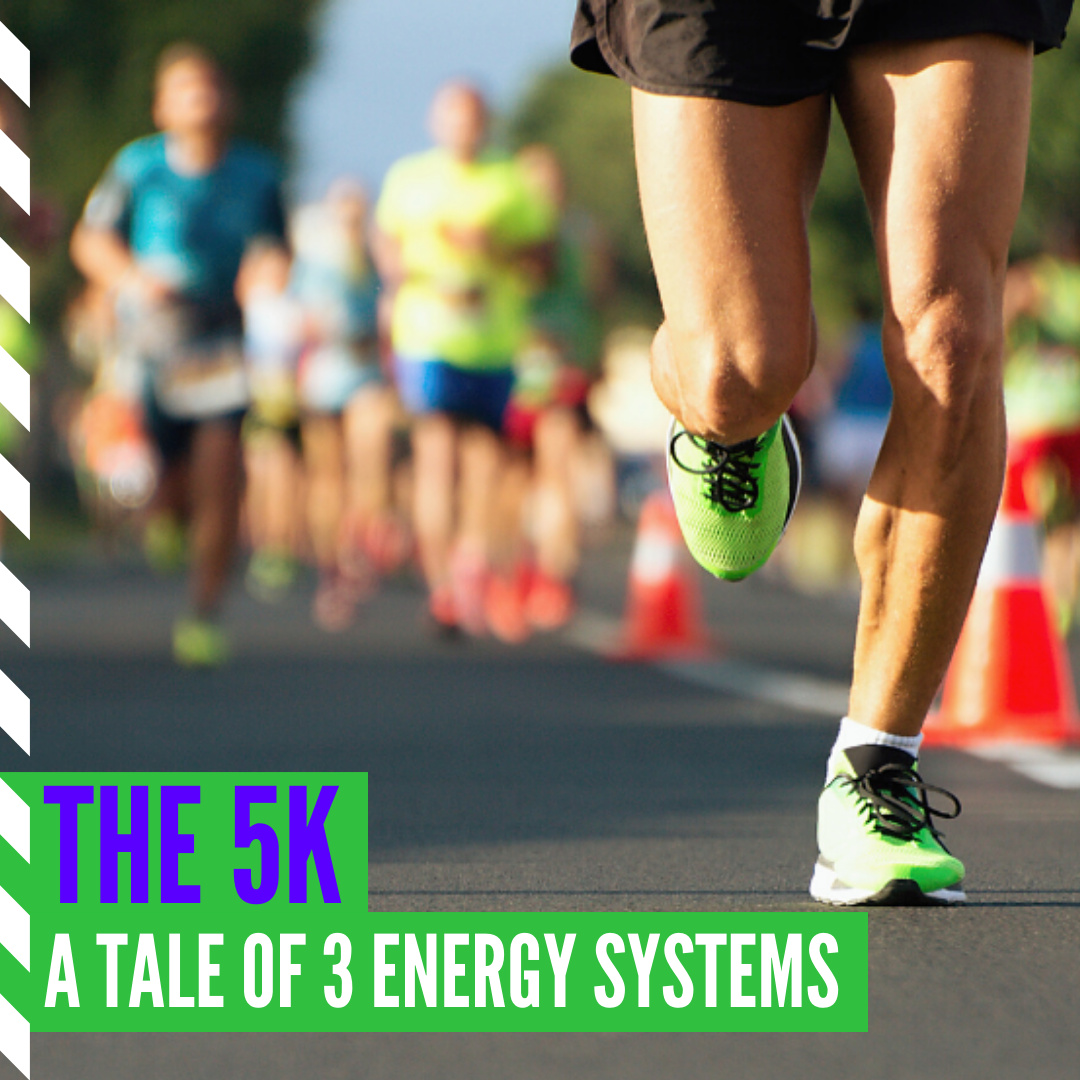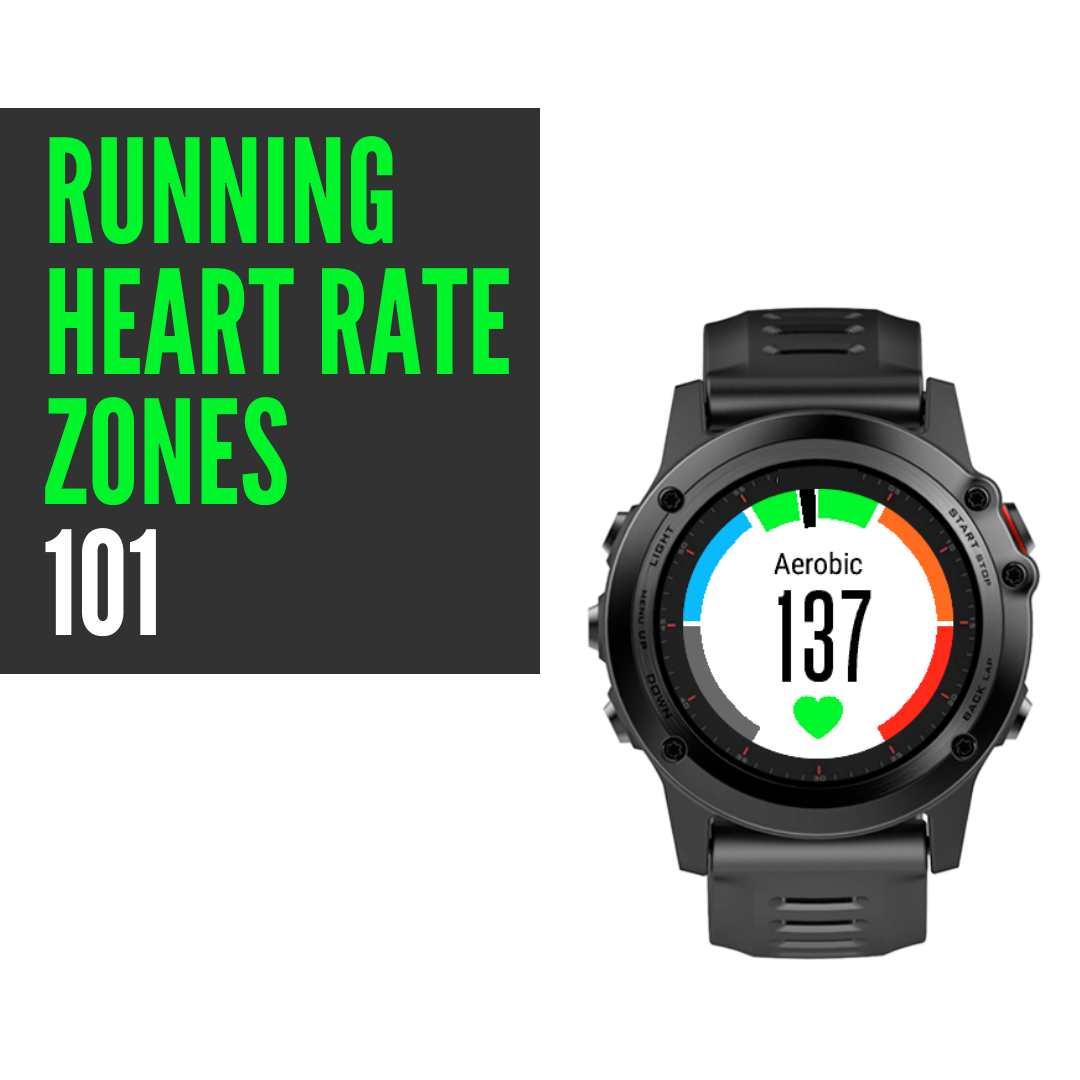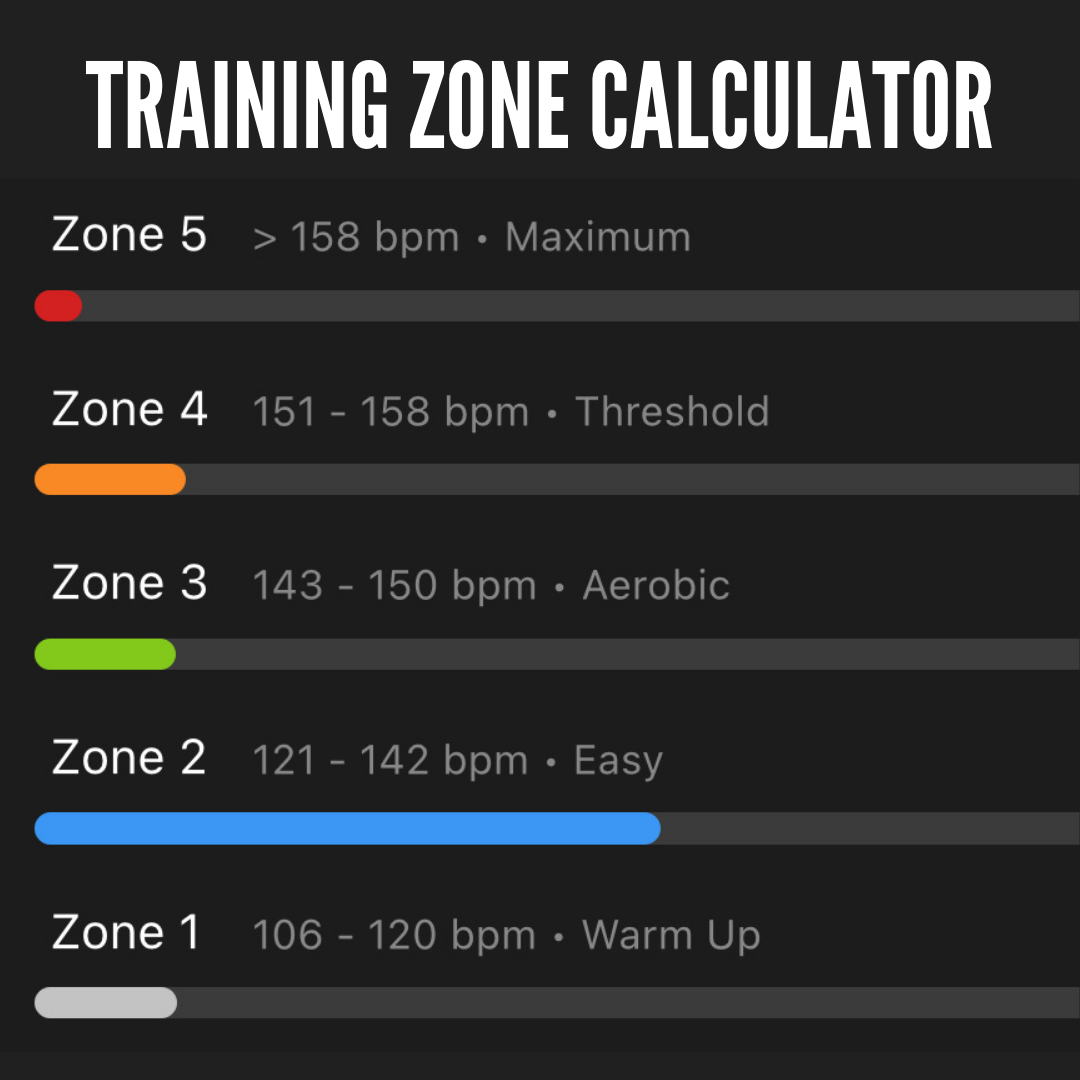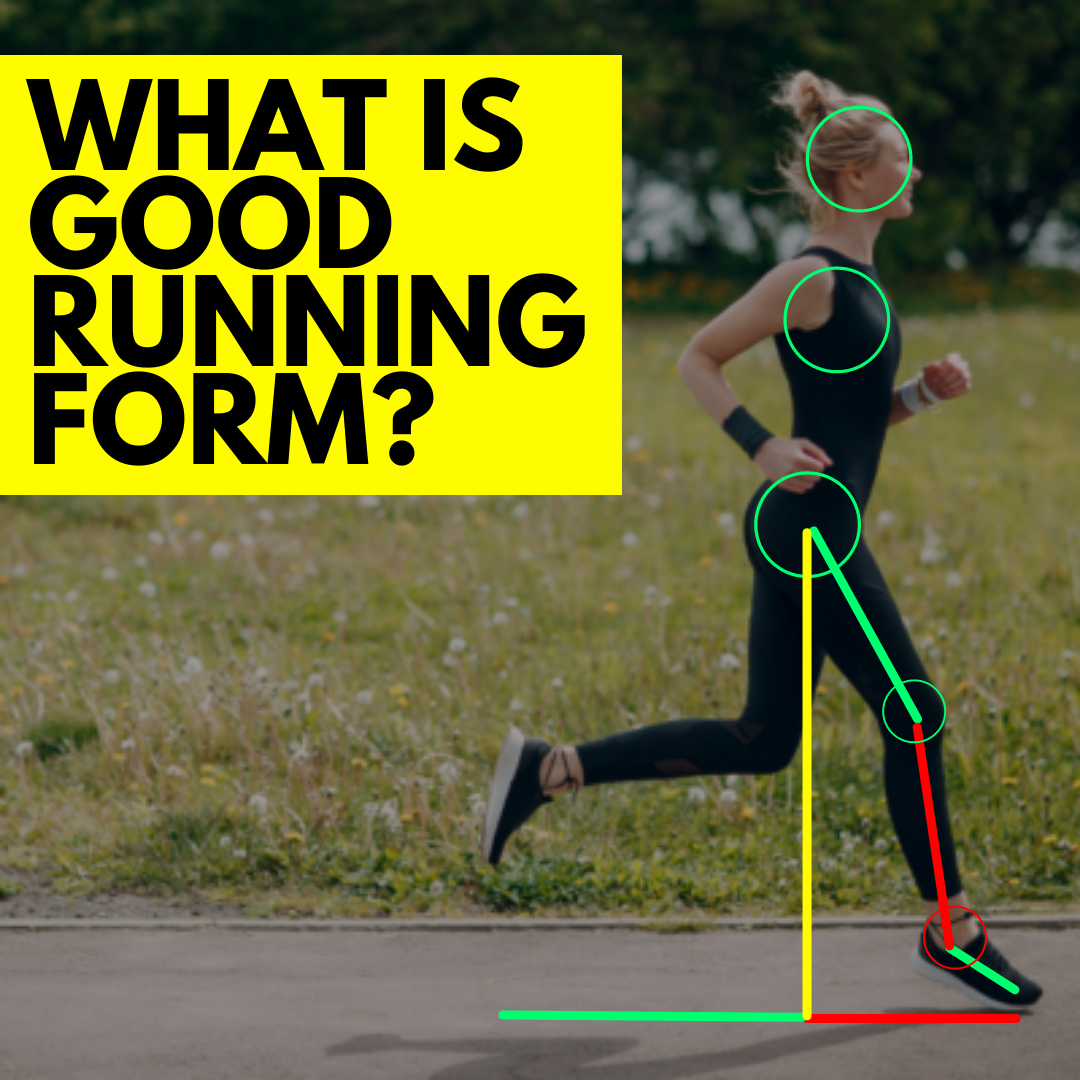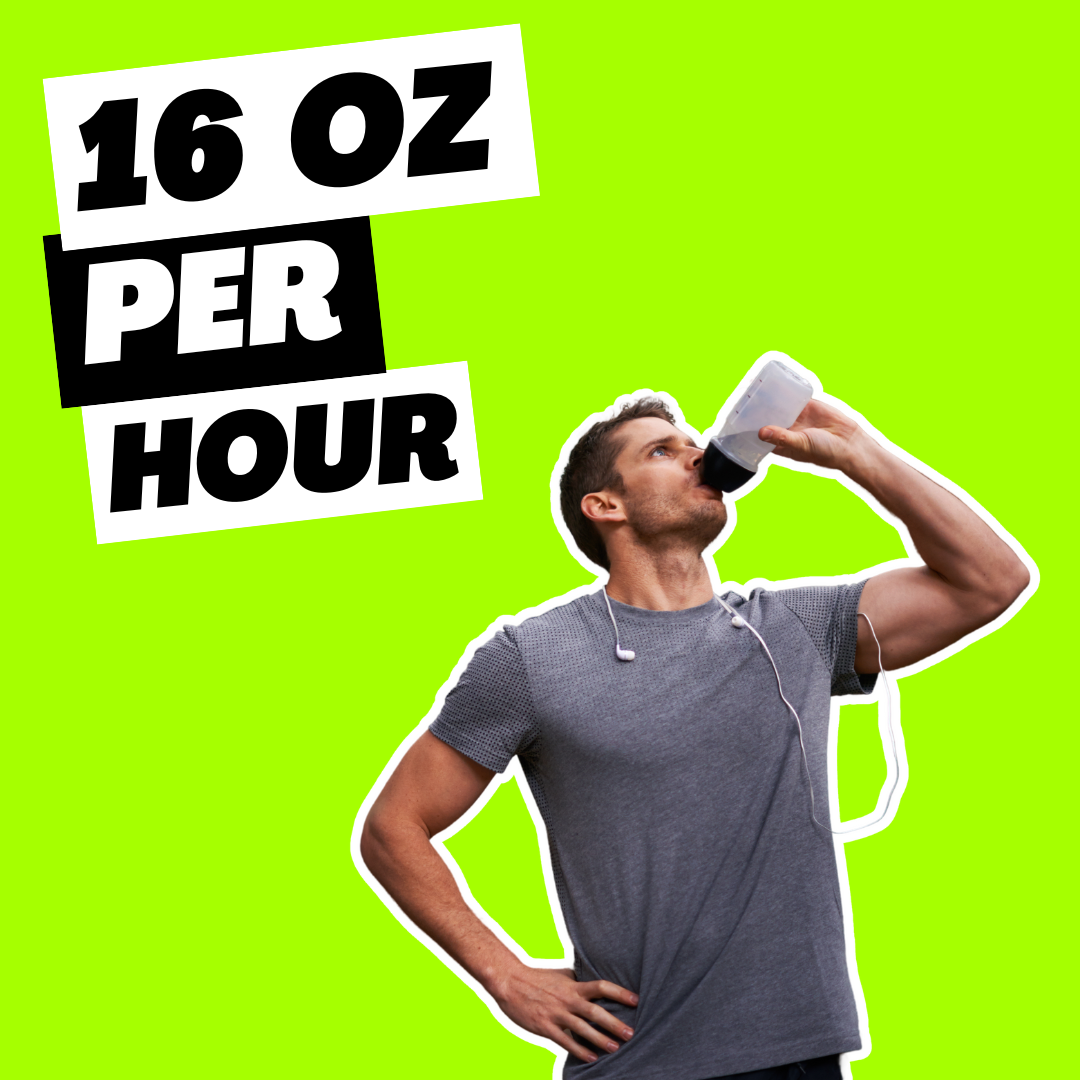Subscribe to The Adaptive Zone Podcast…
A few years back my cousin, Adrian, invited me to do a Park Run. Park Runs are a popular event in the UK. Each weekend runners line up for a 5k race in parks all over the UK. It’s free to join in and a wonderful initiative that I hope finds its way to Red Deer someday.
At the start line, Adrian said something like “I’m going to push it today, so I’ll just find you afterwards”. The clear implication being that I wouldn’t be able to keep up and he’d just have to leave me behind.
Huh, we’ll see about that!
What follows is an epic tale of cellular heroism. We’ll be exploring the physiological activity taking place within the muscle cells during this Battle of Titans. In order to understand performance in the 5k, we’ll need to examine the energy systems involved.
Energy Systems 1 | The Phosphagen System
As the gun goes off, Matthew and Adrian sprint away from the start line
The first of our energy systems is concerned with generating movement as fast as possible. The muscle cells receive their first orders from the brain. Nerve impulses are sent from the brain down the motor neuron (nerve cell). The intersection between the muscle and the nerve is known as the neuromuscular junction. They’re being told to contract as fast and as hard as possible over and over again. The muscle cells look around for some energy to use to fuel the contractions. There’s some Adenosine Triphosphate (ATP) laying around in the cell so they break off a phosphate molecule. The ATP has become Adenosine Diphosphate (ADP). This releases some energy that the muscle cells quickly use for their contractions.

The orders keep coming from the neuromuscular junction though:
- Neuromuscular Junction: “Muscle cell, contract hard and fast, over and over, right now”
- Muscle Cell: “Why?”
- Neuromuscular Junction: “Don’t question my orders cell. This comes right from the top”
- Muscle Cell: “Yes Sir”
The muscle cells look around for more of that handy ATP stuff, but there’s none. They do see some funky-looking Creatine Phosphate (CP) hanging around in the corner of the cell though. As the muscle cell watches on, the CP starts flirting with those ADP molecules and before you know it, they’re getting it on! What ensues is a few milliseconds of passionate coupling and voilà, a beautiful ATP baby!
The muscle cell grabs the ATP baby and mercilessly hacks off its phosphate molecule. Boom. More energy. That will keep the man upstairs happy. As the ATP is broken down into ADP it releases a phosphate molecule and some energy. At the same time, it releases a hydrogen ion. These hydrogen ions gather in the muscle cell and cause the pH to drop, known as acidosis. This produces a burning sensation in the muscles.
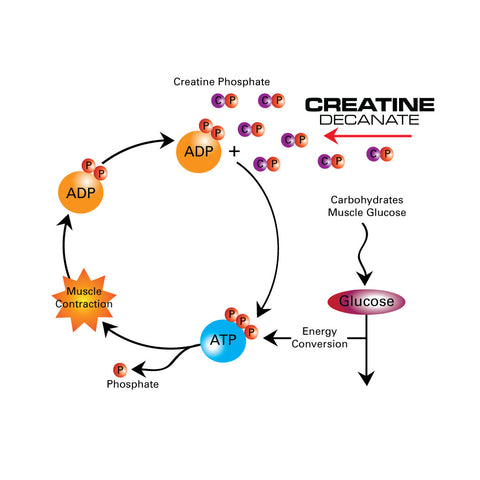
- Muscle Cell: “Sir, we’ve used up all the ATP and all the CP, we’ve created as much energy as we can”
- Neuromuscular Junction: “More contractions, faster, harder”
- Muscle Cell: “With respect Sir, my men have been at it full throttle for almost 30 seconds, we just can maintain this power output. There’s no energy left and all these hydrogen ions are making it really acidy in here”
- Neuromuscular Junction: “Fine, I’ll send it up the chain”
- Muscle Cell: “Yes Sir”
Meanwhile, Matthew’s pace is starting to slow. The all-out sprint becomes a pretty respectable 3:45 min/km pace. Matthew is breathing hard but able to sustain this pace for the time being. Adrian pulls ahead a litte, but his pace has also slowed.
- Neuromuscular Junction: “Okay cell, the man upstairs has agreed to reduce speed, but only a little. Give me all you can”
- Muscle Cell: “Yes Sir, we’ll explore some of our other energy systems”
This article is part of the Running Fundamentals Course.

The Running Fundamentals Course is a free online course to help runners understand the foundations of running performance.
Enter your name and email and I’ll send you one module each week.
Energy Systems 2 | The Glycolytic System
The muscle cell gets to work. It has some glycogen stored up and it starts breaking that down into glucose. The glucose has six carbon molecules. The muscle cell breaks that 6-carbon chain down to produce two 3-carbon chains, these are Pyruvate molecules. This is known as glycolysis and releases 2 ATP molecules per glucose molecule. It will also so produce some Acetyl Coenzyme A (Acetyl-CoA), a molecule that will come in handy later. However, there are some more of those nasty hydrogen ions leftover.
The hydrogen ions being produced by the breakdown of ATP are becoming a real issue. The cell and blood supply are becoming acidotic, which is interfering with the ability of the calcium ions to help produce contractions. The muscle cell starts frantically mixing the hydrogen ions with the pyruvate to create lactate. In this way, the lactate is buffering the acidosis of the muscle cells and bloodstream.
Side Note: The pyruvate and hydrogen ions were originally thought to be lactic acid. This lactic acid was blamed for the muscle burn. However, lactic acid may not actually exist in the muscles during exercise. Many sources still refer to the pyruvate and hydrogen ions as lactic acid, with the lactate being said to “buffer the lactic acid”. I’m not exactly sure about the chemistry here, but the lactate that is produced by the combination of pyruvate and hydrogen ions is actually an alkali, not an acid. It’s probably the hydrogen ions that produce acidosis and muscle burn. For more detail on this, check out this video…
As the concentration of lactate in the muscle cell starts to rise, some of it spills out into the bloodstream. This lactate is shuttled off to the liver, where it is transformed back into glucose and sent back to the muscle cells, this is known as the Cori Cycle.

Image from UESCA
The lactate that spills into the bloodstream will raise the blood-lactate level. This level can be measured by Exercise Physiologists and is an important measurement to determine the intensity of exercise. At first, all of the lactate spilling into the blood can be cleared by the liver. However, if it’s being generated really quickly because the muscle cells are working crazy hard, it can’t be cleared as quickly as it is generated. The blood-lactate level will, therefore, start to rise. The point at which this occurs is known as the lactate threshold or the anaerobic threshold.

This process is known as anaerobic respiration, as it is not using oxygen. As we all know, we can’t sustain a pace that puts us in the anaerobic zone for very long.
The muscle cell is now generating 2 ATP molecules per glucose molecule. It’s time to check in with the neuromuscular junction.
- Muscle Cell: “Sir, we’re getting about 2 ATP molecules for each molecule of glucose. We’re burning through the available glycogen pretty quickly. We won’t be able to sustain this pace for long”
- Neuromuscular Junction: “TWO!? That’s pathetic muscle cell. We’re going to be out of glycogen in no time! All the glucose is already gone!”
- Muscle Cell: “Sir, we’re contracting too hard and too fast. We can only sustain this output for about 2 minutes. We need to slow down. If we slow down a bit we can get some oxygen in here and bring out the big guns”
- Neuromuscular Junction: “You don’t mean…”
- Muscle Cell: “Yes Sir, I’ve sent orders to call him in. It’s time to unleash … The Mitochondria“
Meanwhile, Matthew’s legs are really starting to burn. He’s pushing as hard as he can but he seems to be slowing down anyway. Matthew gradually drops to a 4:00 min/km pace. He’s still got Adrian in sight, but he’s starting to pull away.
Energy Systems 3 | The Oxidative System
The mitochondria arrive on the scene and the muscle cell issues the orders. The mitochondria will be supplied with the Acetyl-CoA molecules leftover from breaking down the pyruvate. It will also get as much oxygen as the blood supply can possibly manage. The mitochondria take that Acetyl-CoA molecule and start cleaving electrons off it in a complicated series of reactions known as the Kreb’s Cycle.

After all its messing around, the Kreb’s Cycle has produced a bunch of NADH and FADH molecules. The mitochondria feed these into the Electron Transport Chain (ETC). These electrons are used in the ETC to create ATP from ADP using an enzyme known as ATP Synthase.
The Muscle Cell comes to check in with the Mitochondria…
- Muscle Cell: “Okay big guy, what have you got for me?”
- Mitochondria: “Sir, for each glucose molecule, we have produced 34 ATP molecules. Sir.”
- Muscle Cell: “34!? Holy Shit! That’s incredible!”
- Mitochondria: “Sir, Yes Sir.”
- Muscle Cell” “I guess they don’t call you The Powerhouse of the Cell for nothing.”
So there it is, the explanation for the only fact that anyone remembers from high school biology:
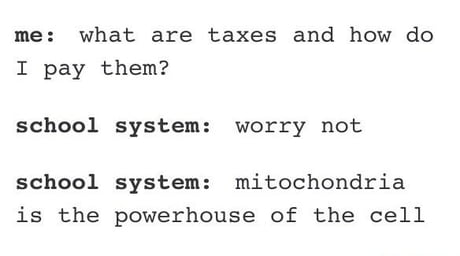
This is how the muscle cells use glucose and oxygen to produce energy (ATP). The waste products of the Kreb’s Cycle and the ETC are Carbon Dioxide (CO2) and water (H2O).

Burning Fats for Fuel
The muscle cell is burning through the available glycogen pretty quickly. Most of the glycogen in the body is stored in the muscles. So it’s easily accessible for the muscle cells to break it down into glucose, then pyruvate, then Acetyl-CoA. This Acetyl-CoA is fed to the mitochondria to produce tons of ATP via the Kreb’s Cycle and the ETC.
The average person can store about 600g of glycogen in the muscles. This is highly variable, as trained athletes can store far more than sedentary individuals. Also, leg muscle size (particularly the thigh) correlates quite well with glycogen storage capacity.
More glycogen is stored in the liver, about 100g or so. This is mostly used to keep your brain working, but we have to prioritize here, so some of this is shuttled up to the muscles to provide glucose. However, glycogen stores will start to run low eventually. Depending on the intensity and the fitness of an individual, glycogen stores will usually last about 90-120 minutes.
This will be plenty of time for Matthew to finish the 5k race (hopefully), however, it wouldn’t be enough time to finish a marathon or even a half marathon. This is thought to be the reason many people “bonk” around the 32km mark in a marathon. Their glycogen stores have been exhausted and the muscles are looking around for other fuel sources.
The muscles really need the Acetly-CoA, not so much the glucose. The Acetly-CoA is the molecule that the mitochondria will gobble up during the Kreb’s Cycle and ETC to produce the ATP. So if there’s no more glycogen around for the muscle cells to turn into Acetyl-CoA, it will start looking for alternative sources.
Under such conditions, the muscle cells can use fatty acids (fats) and amino acids (proteins) to produce the Acetly-CoA. This can be fed to the mitochondria and used to produce ATP in the absence of glycogen. The trouble is that this method uses more oxygen and takes ages. It’s kind of a “slow-burner”. You can get a long and steady stream of ATP using this method, but it comes out at a trickle. This method is used to produce very long, very slow releases of energy. More common for events that take hours, such as marathons or ironmans.
In this 5k race, there won’t be a lot of “burning fats for fuel”, but I thought it was worth including here just to complete the picture.

Fatigue
Matthew and Adrian have managed to sustain that 4:00 min/km pace. They’re nearing the finish line but they are both starting to slow down. They gasp desperately for air, but no matter how hard they push, their legs just won’t move as quickly as they were before.
As their muscles contract repeatedly, some of the energy is lost as heat and they get progressively warmer. The body has to shunt some of the blood closer to the surface of the skin to cool it down. This reduces blood supply to the muscles, depriving them of oxygen and glucose, as well as reducing lactate clearance.
The Muscle Cell comes to check in with the Neuromuscular Junction…
- Muscle Cell: “Sir, we’re maxing out but we can sustain this output. We are producing enough ATP and the mitochondria tell me they have sufficient oxygen. Glycogen supplies are depleting but we probably have enough for a couple of hours yet. Although our lactate and hydrogen levels are rising, we’re clearing enough to sustain the neutral pH for at least an hour. What are your orders, Sir?”
- Neuromuscular Junction: “Very good Cell, continue at the current ________. Maintain muscle __________ at this intensity and _________”
- Muscle Cell: “Sir, you’re breaking up, what was that order?”
- Neuromuscular Junction: “Continue at the __________ ________. Maintain muscle __________ at this __________ and _________”
- Muscle Cell: “Sir, I’m losing communication, what are your orders? Should we continue contractions?”
- Neuromuscular Junction: “_______ at the __________ ________. ____________ muscle __________ at _______ __________ and _________”
As the contractions continue, ions on either side of the muscle cell membrane are dispersed. Concentrations of Calcium, Potassium and Sodium near the muscle cell membrane are reduced. When the signal comes from the motor neuron to the neuromuscular junction, the muscle cells lack sufficient ions to generate an action potential, so it is unable to contract. This concept is outlines in a bit more detail in this video…
It’s as if the communication link between the motor neuron and the muscle cell is experiencing severe “static”. Rather than orders to continue contractions, the muscle cell just gets white noise punctuated with illegible message fragments. Unable to generate contractions, muscle output starts to dwindle.
Matthew and Adrian are both slowing dramatically. The best they can muster is a 4:30 min/km pace. The finish line is in sight. Slowly but surely, Matthew starts to narrow the gap.
All of the training in the last few months has caused adaptations in Matthew’s muscles. The muscles in his legs are bigger thanks to hypertrophy. The capillary networks supplying the oxygen are denser. His mitochondria are larger and more numerous. His muscle glycogen stores are bigger. He generates the same force of muscle contraction using fewer nerve impulses. This depletes the ion reserves around the neuromuscular junction more slowly, maintaining communication between the motor neuron and the muscle for longer.
Adrian is slowing considerably now. He can only sustain a 5:00 min/km pace. Matthew is closing the gap, 30m, 20m, 10m…
Matthew passes Adrian on his right. He supresses the pain long enough to look like he’s barely trying and gives Adrian a little smile.
Matthew crosses the finish line a few seconds before his cousin. His foe vanquished, victory is his.
As they rest at the finish line, heavy breathing starts to slow. The oxygen debt that was built up by the anaerobic respiration is being repaid. Slowly, ions will flow in from other areas of the body. Once concentrations are high enough near the muscle cell membrane, action potentials can be generated and contractions produced. However, the race is over, so there’s no need for that right now. Glycogen stores will be replenished over the next 24-48 hours.
Training Effect on the Energy Systems
Taxing these energy systems and then allowing them to recover is how we elicit the training effect. The depletion of glycogen stores within the cell will send a signal to the body. The muscle cells will increase their glycogen stores, just in case this happens again. The same goes for creatine phosphate. Some of the muscle cells have been damaged by the effort. During repair, the body will make these cells bigger and stronger. This is known as muscle hypertrophy. The signals to the body that more mitochondria and more capillary network density are a priority will be reinforced. To learn more about that, check out this article…
Related Article
Energy Systems: Summary
The easiest way to understand the energy systems is to think of burning stuff.
Burning a wooden log takes a while to get going. When it does it will burn slowly and last ages. It will release its energy at a slow trickle over many hours. This is The Oxidative System. The wood represents the glycogen, or even fatty acids if you’re running really slow.
Burning a piece of paper is pretty quick. It’s easy to set alight and it will burn up and release all of its energy within a minute or two. This is The Glycolytic System. The paper represents glucose.
The Phosphagen System? Well, that’s a firecracker! All of its energy is released explosively, almost instantly, then it’s done. The gunpowder in the firecracker represents the creatine phosphate and readily available ATP.
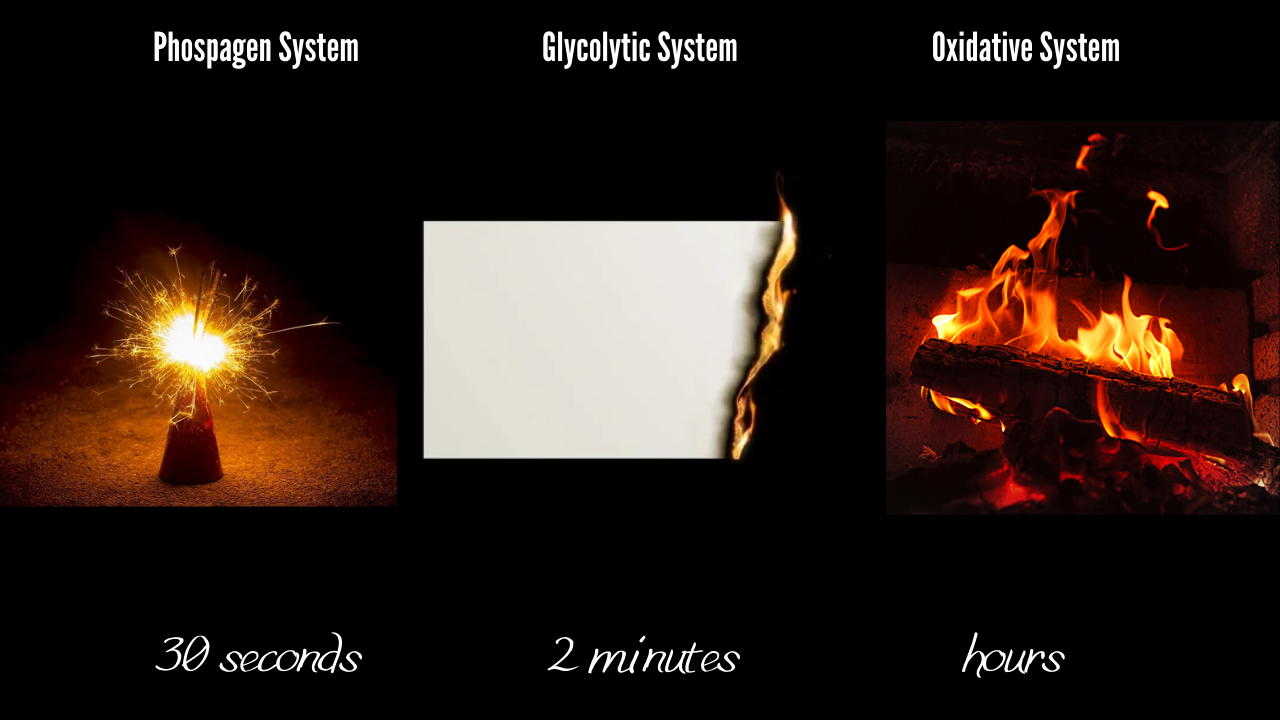
In the next module, we’re going to take a deep dive into one of the most important physiological markers related to endurance performance, the lactate threshold.
Next Module

The Running Fundamentals Course is a free online course to help runners understand the foundations of running performance.
Enter your name and email and I’ll send you one module each week.
